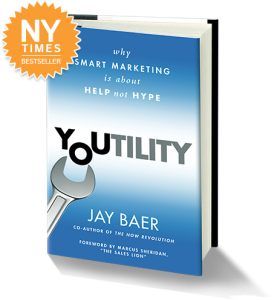Brand Book Bites from Youtility
(“brand book bites” are book write-ups that highlight the most interesting brand stories in the latest best-selling books. Subscribe to my feed so you don’t miss these regular bulleted briefings on the books I recommend.)
– the book: Youtility: Why Smart Marketing Is About Help Not Hype – a helpful read about helpful marketing
– the brain: A couple of years ago, digital marketing guru Jay Baer shook things up with The Now Revolution, a book about how the social web fundamentally changes the way we do business. With Youtility, he’s done it again, making a convincing case for a new era in marketing.
– the best bits: Youtility – defined as “massively useful information, provided for free, that creates long-term trust and kinship between your company and your customers” — is a different, better way of marketing because it’s marketing that’s actually wanted by customers. Examples include the Sit or Squat app from Charmin that helps people find decent restroom facilities and the 850 pages of information that the folks at River Pools and Spas put on their website to help prospective customers.
- “If you sell something, you make a customer today; if you help someone, you make a customer for life.” – In this time-deprived, ADD culture, traditional marketing is losing its effectiveness.
- “Youtility doesn’t overcome all other product and price dynamics, but it gives the brand that extra edge, the tiebreaker that allows it to ultimately sell more by ‘selling’ less.” – Just like traditional marketing, Youtility isn’t a cure-all, but it does win customers over by providing something of value that’s different and relevant.
- “The branding ligaments that for decades created cohesive corporate attributes have been surgically removed. Brands have rush to provide value (optimally) or promotions (typically) on every new communications platform, all of which are increasing accessed through mobile devices, making customers’ relationships with brands solely a collection of micro-experiences. This is the ‘app-ification’ of brand value.” – With such fragmented brand experiences, brands have the opportunity – and the challenge — to convey value in each touchpoint.
– the brand stories: Youtility describes the Meijer Find-It app which helps shoppers locate specific products in the store, plan a trip within the store to maximize efficiency, and locate store services such as restrooms. I thought this app sounded terrific but I feared that Meijer would end up doing what I’ve seen many app providers do — add to the app a bunch of other functionality that complicates something intended to simplify. I asked Jay about this risk. “Where we are with apps today is where we were with websites in late 90’s – people keep on adding features,” he answered. “The best apps are the ones that do the least amount of things.” [emphasis mine]
We also talked about the app from Columbia Sportswear called “What Knot to Do in the Greater Outdoors,” which, as the name suggests, provides detailed instructions for which knots to use when and how to tie them. Jay explained that the genius of this app is that it’s not about Columbia. The brand could have developed a shopping app that helps you pick out the best jacket, but that “doesn’t have legs and doesn’t allow you to do anything you’re not already doing. The best apps are not about products and services,” Jay said. “The best transcend the transactional and get involved in customers’ lives in ways that are relevant but broaden the relationship.”
– the bottom line: This book will help you think about marketing in a completely different way. And best of all, Jay puts his money where his mouth is: the book itself provides useful tips and instructive case studies – and it came without an unnecessary and un-useful paper jacket.
other brand book bites:
- The Business of Belief by Tom Asacker
- Can’t Buy Me Like by Bob Garfield and Doug Levy
- Monster Loyalty by Jackie Huba